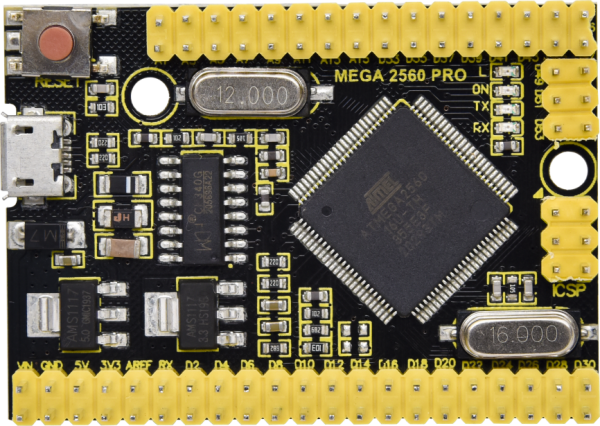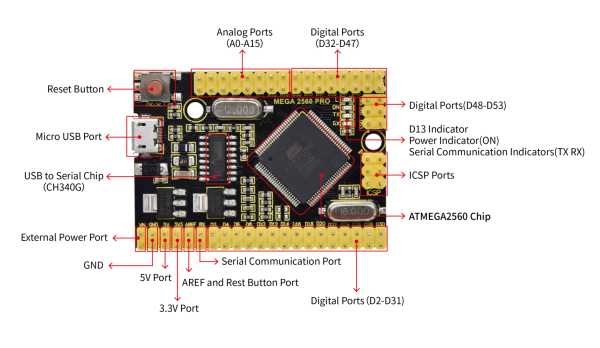KS0502 Keyestudio MEGA 2560 PRO Development Board(Black and Eco-friendly)
Introduction
The mega 2560 control board, among the series of MCUs , is the most popular since it has numerous pins. However, a substantial of pins don’t meet the space demand of DIY design. To tackle this issue, we roll out the Keyestudio MEGA 2560 PRO development board. In fact, its use method is as same as the official mega board, in addition to the different volume.
Its processor core is ATMEGA2560-16AU. In the meantime, it has 54 digital input/output pins (of which 15 can be used as PWM outputs), 16 analog inputs, 4 channel serial communication ports, a USB connection, 1 ICSP header, and a reset button. And all ports are extended by pins with the interval of 2.54mm. What’s more, you can burn the firmware for ATMEGA2560-16AU through the built-in ICSP port. Luckily, the firmware of this chip is burnt well before delivery, therefore, you don’t need to burn firmware.
The power can be supplies through USB cable, port 5V , GND(DC 5V), as well as Vin GND (DC 7-12V).
Specification
- Microcontroller: ATMEGA2560-16AU
- USB to serial chip:CH340G
- Operating Voltage: 5V
- Input Voltage (recommended):DC 7-12V
- Digital I/O Pins: 54 (D0-D53)
- PWM Digital I/O Pins:15(D2-D13 D44-D46)
- Analog Input Pins: 16(A0-A15)
- DC Current per I/O Pin: 20 mA
- DC Current for 3.3V Pin: 50 mA
- Flash Memory: 256 KB of which 8 KB used by bootloader
- SRAM: 8 KB
- EEPROM: 4 KB
- Clock Speed: 16 MHz
- LED_BUILTIN:D13
Pin Interfaces:
| 1 | External Power Ports | External input: DC 7-12V |
| 2 | Ground | GND |
| 3 | LED indicator(TX) | 5V DC 5V input/output voltage(supply power for control board when inputting 5V) |
| 4 | LED indicator(POW) | Power up the control board, LED on, otherwise LED off. |
| 5 | LED indicator(L) | There is a built-in LED driven by digital pin 13. When the pin is HIGH value, the LED is on, when the pin is LOW, it's off. |
| 6 | RX0(D0)TX1(D1)D2-D13 |
It has 14 digital input/output pins D0-D13 (of which 6 can be used as PWM outputs). These pins can be configured as digital input pin to read the logic value (0 or 1). Or used as digital output pin to drive different modules like LED, relay, etc. |
| 7 | RST | Reset pin: connect external button. The function is the same as RESET button. |
| 8 | MEGA 328P | Each board has its own microcontroller. You can regard it as the brain of your board. Microcontrollers are usually from ATMEL. Before you load a new program on the Arduino IDE, you must know what IC is on your board. This information can be checked at the top surface of IC. |
| 9 | MINI USB | The board can be powered via Mini-B USB connection. Also upload the program to the board via USB port. |
| 10 | 3V3 pin | rovides 3.3V voltage output |
| 11 | REF | Reference external voltage (0-5 volts) for the analog input pins. Used with analogReference(). |
| 12 | A0-A7 | The Nano has 8 Analog Pins, labeled A0 through A7. |
| 13 | 5V pin | Provides 5V voltage output |
| 14 | GND | Ground pin |
| 15 | VIN | Input an external voltage DC7-12V to power the board. |
| 16 | Reset Button | Used to reset the control board |
| 17 | CH340G | USB-to-serial port chip, converting the USB signal into Serial port signal. |
| 18 | AMS1117 | Convert the external voltage input DC7-12V into DC5V, then transfer it to the processor and other elements. |

